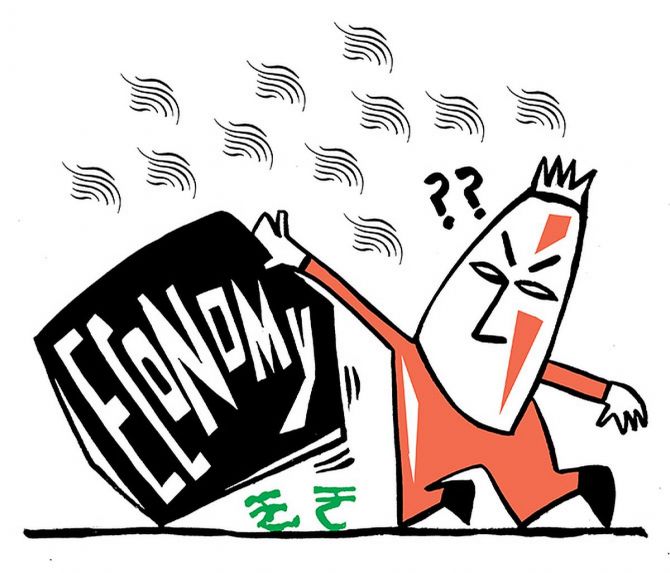The government's second round of stimulus will spur consumer spending in the near term but support to economic growth will be minimal, Moody's Investors Service said on Thursday.

After a long clamour for fiscal stimulus, the government had on October 12 come up with measures with direct fiscal support to people and states and to generate demand.
These included a leave travel concession (LTC) cash voucher scheme and special festival advance for government employees and Rs 12,000 crore interest-free loan to states and Rs 25,000 crore additional capex.
The stimulus, amounting to Rs 46,700 crore, or about 0.2 per cent of real gross domestic product (GDP) forecast for FY 2021, "highlights limited budgetary firepower to support the economy during a very sharp contraction," Moody's said.
The new stimulus aims to boost consumer spending during the festive season and to increase capital expenditures.
"Even when combined with the government's fiscal stimulus earlier in 2020, the size of the measures remains modest.
“In total, the two rounds of stimulus bring the government's direct spending on coronavirus-related fiscal support to around 1.2 per cent of GDP," the rating agency said.
This compares with an average of around 2.5 per cent of GDP for BAA-rated peers as of mid-June.
"India's very weak fiscal position has constrained its scope for discretionary stimulus spending in response to the coronavirus shock," Moody's said projecting general government debt burden to peak at around 90 per cent of GDP this year, up from about 72 per cent of GDP last year.
The large debt burden is driven by chronically wide fiscal deficits.
Moody's said weaker government revenue, driven by the economic contraction and reduced corporate tax rates announced in September 2019, would widen the general government deficit to around 12 per cent of GDP in the current fiscal.
"While the latest stimulus will spur consumer spending over the near term as coronavirus-related restrictions continue to be eased and India's festive season begins, the support to growth will be minimal," it said.
The government expects the new stimulus to add around 0.5 per cent of GDP - a small boost compared with the forecasted 11.5 per cent drop in real GDP in 2020-21, it said.
Moody's said consumer confidence has remained subdued even as India has emerged from a very stringent nationwide lockdown, which drove a 24.5 per cent contraction in private consumption in the April-June quarter, compared with the previous year.
The number of coronavirus cases in India is still elevated and the relaxation of restrictions on educational establishments, entertainment facilities and gatherings from October 15 raises the risk of spread, which could weigh further on consumer sentiment.
As part of the latest stimulus, the LTC Cash Voucher Scheme will provide cash payments to public sector employees and applicable private-sector employees in place of annual leave encashment (money received in exchange for a period of leave) and travel reimbursements available to them.
The purchases must be made on goods subject to a consumption tax of at least 12 per cent, and transactions must be digital and fall within 2020-21 fiscal.
In addition, the Special Festival Advance Scheme will offer Rs 10,000 interest-free advances to central government employees, with the same spending deadline, and will require repayment over a maximum of 10 instalments over 2021-22.
To boost public investment, state governments will receive 50-year interest-free loans amounting to Rs 12,000 crore, with the loan amount varying by state.
The loans may be used for capital projects and must be utilised within 2020-21.
The government will also commit an additional Rs 25,000 crore for infrastructure projects and domestically made capital equipment, on top of the Rs 4.1 lakh crore allocated for infrastructure expenditure in the 2020-21 budget, it said.
"We forecast growth to rebound to 10.6 per cent in fiscal 2021-22, reflecting the comparison with the low GDP levels of 2020 as economic activity gradually normalises," Moody's said.
Over the medium term, Moody's expect growth to settle around 6 per cent, with downside risks due in part to ongoing stress within the financial system.
Moody's said a series of the recent agricultural sector and labour law reforms, which were announced as part of broader structural reforms and approved by Parliament in September, could provide support to medium-term growth if implemented effectively.
The agriculture reforms aim to increase efficiencies in the fragmented supply chain by expanding farmers' direct access to produce markets.
The labour law reforms consolidate and amend laws related to trade unions, conditions of employment in industrial establishments, and settlement of industrial disputes.
"Of particular significance is the raising of the threshold at which an employer must seek government approval for layoffs, to 300 from 100 workers, which provides some increased flexibility to employers and could help to increase India's competitiveness," it said.











 © 2025
© 2025